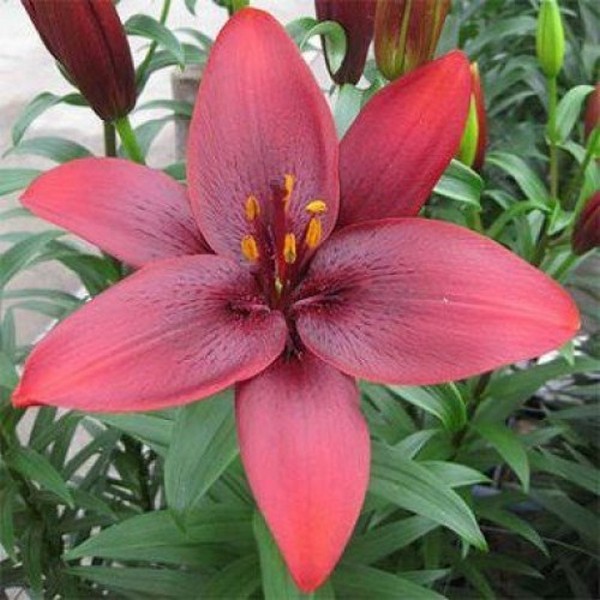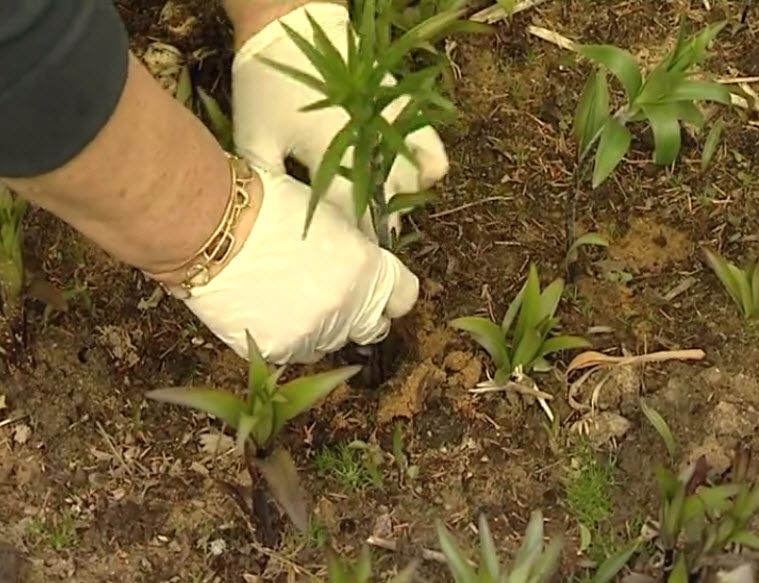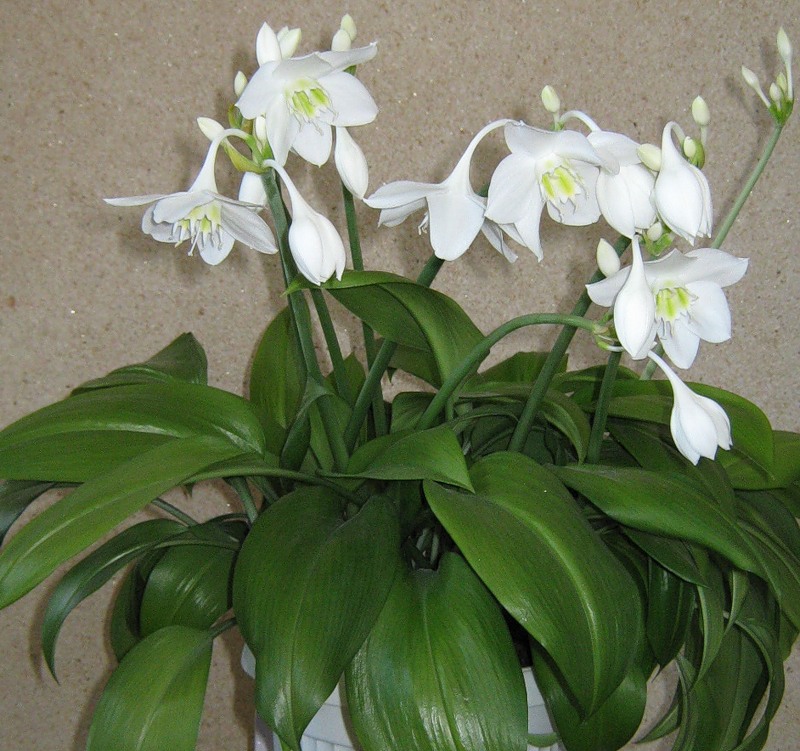Content:
Asian hybrids of lilies are the most common group of these fragrant flowers found in Russian gardens. They got their name due to the fact that the majority, in fact, are of oriental origin.
Asian lily - planting and care in the open field
Asian hybrids are a fairly large group of beautiful and hardy lily varieties, uniting about 2000 varieties. They became widespread in the 1950s in America, where breeder Jan de Graaf bred a variety he named Mid-Century. At first, it contained only flowers with orange and red petals, but gradually new hybrid varieties with lilac and pink petals appeared. In Russia, the first variety was created by Michurin himself on the basis of Shovitsa and Spotted lily. The new variety was named Fialkov because it had a pleasant aroma. Since the 1960s, more than a hundred varieties of Asian hybrids have been bred at the Michurin All-Russian Research Institute of Horticulture.
These oriental lilies are distinguished by turbid, calyx-like flowers, reaching a diameter of 8-10 cm (although there are also varieties with a diameter of up to 20 cm). They can be directed up, to the side (in relation to the stem) or down - and then they will be called drooping. Their colors can be very diverse. There are both orange and yellow, and cream, pink, burgundy and even practical black flowers. There are also lighter hybrids - the same snow-white, like a water lily, which is called a water lily for a reason. They bloom in late June or early July, depending on the specific variety.
Lily Asia is a beautiful and unpretentious class of hybrids. Several more subspecies are distinguished among this group. For example, these are hybrids of the Asian terry lily. They are distinguished by the characteristic shape of the petals and corollas. This variety includes many hybrids, including Aphrodite, a flower native to Holland. This hybrid is distinguished by large pale pink flowers with an increased number of elongated petals. In one inflorescence, up to 30 pieces can be collected, and the bush reaches a width of 50 cm.
Another beautiful terry hybrid is called the Eagle Eye. It has fiery orange petals. Eagle Eye has large flowers, and the bush itself grows to a height of 70 cm. It grows easily, pleases the eye with abundant and long flowering and practically does not require maintenance.
Another group is the yellow Asiatic lily. This variety also includes many beautiful hybrids. For example, this is the Nove Cento variety with bright yellow petals. The advantage of this lily lies in the length of flowering and large flowers up to 16 cm in diameter, which bloom on stems up to 1 m high. This hybrid also has a bright pollen.
All Asian lilies are distinguished by their hardiness and good winter hardiness, which makes them popular in Russia. These flowers are unpretentious, they can grow equally well in partial shade and in open areas illuminated by the sun.
Landing and preparation rules
Spring is not the best time to plant lily bulbs, although in some regions where the snow melts in April it is possible to plant them at this time of year. The main thing is that the soil has time to thaw.But in most regions, the gardener needs to wait for autumn for this. But the bulbs must be preserved until this time. To do this, they are treated with a fungicide so that the fungus does not start, and they are wrapped in moderately damp thick paper. Some gardeners advise using not paper for these purposes, but slightly damp sawdust or peat. Then the bulbs are placed in plastic bags, in which holes are previously made so that the plant can breathe, and in this form they are stored in the refrigerator, maintaining the temperature at a level of 0 to + 5 ° C. If the temperature rises, the bulbs will sprout.
Autumn is the best time to plant lilies, as the bulbs will be able to take root before the growing season and the plant will do well next year. It is best to plant them in the soil in September-October.
Asian hybrids - lilies are unpretentious. But they love light, and therefore will bloom more abundantly in open areas. It is recommended that you choose a place for them so that they are in the sun for about half a day. Lilies can be grown along fences or low buildings. You can find a place near trees or shrubs, but taking into account the rule described above.
Before planting in the soil, you need to dig small holes about 25 cm deep and of the same diameter.
Asian hybrids prefer slightly acidic soils. If the soil on the site is clayey or heavy soddy, then sand and peat should be added. But fresh manure cannot be used for fertilization, because, unlike non-bulbous plants, this is fraught with the development of fungal diseases in lilies.
The bulbs are planted to a depth of 10 cm - depending on the original size of the planting material. The distance between plantings should not be less than 35 cm. It is recommended to spill the wells with a fungicide solution to avoid decay.
Asiatic lily care after planting in the ground
Taking care of Asiatic lilies after planting in the ground is not so difficult. You just need to ensure that they receive enough moisture.
Since mid-July, nitrogen fertilization is not carried out. A good alternative is potash and phosphate fertilizers to replenish substances that have been spent on development and flowering.
Asian hybrids can be grown at home, in large enough containers, on the terrace. Such potted plantings can be quite high, so from the very beginning you need to choose a container of a suitable size for them. If the landing was successful, then soon the first shoots will appear. All this time, it is important to ensure watering, which is carried out as soon as it becomes clear that the earthen lump has dried up, about once every three days.
Home lilies do not require much maintenance. The first feeding is carried out after seedling emergence. For this, organic fertilizers are used. A week later, another top dressing is carried out, but already with the use of a phosphorus-potassium composition. During the growing period, plantings can be sprayed. For this, a growth stimulator is used, and spraying is carried out approximately twice a week. This will help you achieve more buds.
In general, all the care of a home lily consists in regularly loosening the soil. Good drainage is also a prerequisite for potted plantings. Watering should be carried out daily, but avoiding waterlogging of the soil. The potted plant can be taken outside, but must be hardened first. The scheme here is as follows - on the first day the plant is taken out for half an hour, the next day for an hour, another day - for 2 hours. Gradually, it will be possible to increase the time spent outdoors up to 10 hours a day.Thus, growing a lily in a pot is not that difficult if you follow the basic rules.
Tips from experienced florists for growing lilies
For this plant, mulching is considered an important agricultural technique. Fallen leaves or needles, pine bark, straw are used. The thickness of the mulching layer must be at least 5 cm.
Growing Asiatic lilies is not difficult. In addition to timely feeding, it is important for them only to remove wilted flowers on time, and with the ovary together. If this is not done, seed pods are formed, and this should not be allowed, because the cultivation of a certain type of lily requires the use of bulbs. In September, when the leaves of the plant are just beginning to turn yellow, it is recommended to cut the stem almost at ground level. This mass is not suitable for compost, it must be burned.
Following these rules, you can achieve abundant and long-lasting flowering of lilies. These hardy plants are found almost everywhere, right up to Alaska, so you can safely buy their bulbs and plant them on the site.















